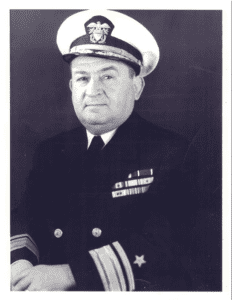
Solomon Isquith was born in 1896, in Brooklyn, New York, the second of seven children. As a young adult, he wanted to join the Navy, but did not meet the height requirements, standing at only 5’4”. As far as the family story goes, Solomon went home that night, tied flatirons around his feel and slept with them dangling over the edge of the bed to stretch out his legs slightly. When he later returned to the recruiting office, he passed all physical requirements and was admitted into the Naval Academy.
Isquith graduated from the Naval Academy in 1920, and was assigned to the USS Utah in Pearl Harbor as an Engineering Officer. He was the senior officer aboard the ship when it was attacked on December 7, 1941. The USS Utah was one of the first ships attacked that morning, and while orders were given to abandon the ship Commandor Isquith decided to make rounds to ensure there were no sailors still on board. He was almost fatally trapped himself, until the ship began to turn as it was sinking and he found a blocked hatch to escape from. As he was going through the porthole, the table that he was standing on slipped out from beneath him. Luckily, there was another service member outside who was able to grab Isquith’s arms just in time and pull him out to safety. Moments later the ship capsized and began to sink.
Once Isquith had safely reached the shore himself, he and other men heard knocking sounds coming from within the sinking USS Utah. Despite the Japanese planes still targeting the area, Isquith and other volunteers hurried back to the ship to investigate. Isquith and the others managed to cut through steel, and rescue another ten men from the ship. Overall, only 64 men lost their life on the USS Utah, and 460 were saved, including those by Commander Isquith.
Commander Solomon Isquith received a Purple Heart and Navy Cross for his rescue efforts on the sinking Utah. His Navy Cross citation reads: “For distinguished service in line of his profession as Commanding Officer of the U.S.S. UTAH during the attack on the Fleet in Pearl Harbor, Territory of Hawaii, by Japanese forces on December 7, 1941. With extraordinary courage and disregard of his own safety, Lieutenant Commander Isquith directed the abandonment of the ship, when it was capsizing rapidly, in such a cool and efficient manner that approximately ninety per cent of the crew were saved.”
After the attack on Pearl Harbor, Commander Isquith stayed stationed at Pearl Harbor to help with salvage other damages, such as those to the USS Oklahoma. After that he took command over the USS Noble in the Pacific, and in 1947 retired from the Navy as a Rear Admiral.
- Profile: Aaron and Dan Schilleci
- Profile: Abe Johnson
- Profile: Alexander Goode
- Profile: Amram Cohen
- Profile: David Camden de Leon
- Profile: Edward Feldman
- Profile: Elkan Voorsanger
- Profile: Frances Slanger
- Profile: Gerald Fink
- Profile: Hank Greenberg
- Profile: Harry Ettlinger
- Profile: Hyman Goldberg
- Profile: Isadore Kahn
- Profile: Jack Miller
- Profile: Jacob Heckman
- Profile: Julius Adler
- Profile: Kate Karpeles
- Profile: Kenneth Rubin
- Profile: Larry Liss
- Profile: Leo Rosskamm
- Profile: Louis W. Freedman
- Profile: Marita Silverman
- Profile: Melvin Garten
- Profile: Miranda Bloch
- Profile: Mordecai Sheftall
- Profile: Phoebe Levy Pember